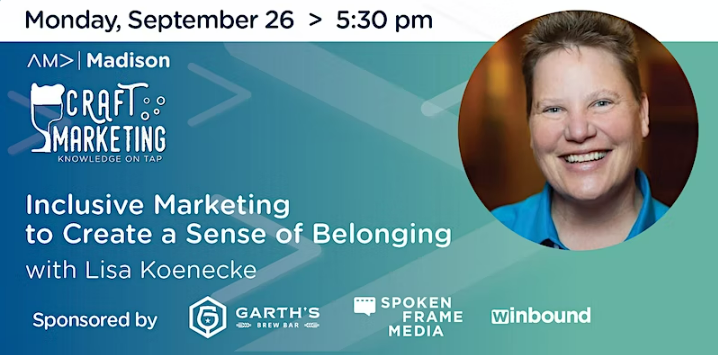It’s 2022, and diversity, equity, and inclusion are at the forefront of the minds of marketers and customers alike. In fact, 70% of audiences respond well to DEI in marketing. One thing’s clear: People want to feel welcomed, valued, and a sense of belonging both as employees and as customers. So, what steps can you take to be more inclusive in your marketing?
Lisa Konecke of Inclusion Ally, LLC joined AMA Madison’s Craft Marketing event on September 26th to answer this question. In her presentation, she guided marketers through the world of inclusive marketing and how to create a sense of belonging for everyone by elevating, representing, and welcoming different identities through content and action.
Let’s dive into the six strategies Lisa shared that you can put into action now. Plus, read to the end for a list of questions to ask your brand for all 5 of the senses.
But First, What is Inclusive Marketing?
At its core, inclusive marketing is about creating content that reflects the diverse communities your organization serves. These efforts should work to decrease biases and elevate the stories and voices of people who have been historically underrepresented or marginalized. When done right, inclusive marketing can deepen connections with customers, build employee satisfaction, and lead positive change.
Lisa said it best: You truly have the ability to change the world, lives, and behaviors.
She then laid out the six inclusive marketing principles that marketers need to know:
6 Inclusive Marketing Principles
1. Start with Tone
Tone refers to the characteristic, style, or sentiment of your content. To ensure you’re conveying a respectful tone, carefully consider your intended topic, message, subject, and impact. Before diving deep into your content’s creation, however, you may want to consult different perspectives. They may be able to pick up on concerns you didn’t think of.
Lisa’s Example: When starting a presentation or even introducing yourself, instead of saying, “I’m Lisa, and I’m from Madison, Wisconsin,” you could say, “I’m Lisa, and I’m from the Land of the Ho-Chunk Nation in Madison, Wisconsin.” Doing so sets a respectful tone and precedent for the interaction. It may even start important conversations.
2. Be Intentional with Language
Language is the phrases, symbols, metaphors, and words you use when you describe something. It can create a deeper understanding and build relationships or tear them down and create misunderstanding. As a result, take the time to consider every aspect of your words and their placement.
Lisa’s Example: Shift your greetings. Instead of saying, “Hello, Ladies and Gentlemen,” say, “Hello, friends/individuals.”
3. Ensure Representation
Representation is defined as the visibility of a variety of identities in your content, whether it’s a video, story, or image. There’s no better way to help your audience feel empowered and seen than to let them see themselves reflected in your content. When gathering speakers for an event or models for a photoshoot, ask yourself, “Are these choices uplifting diverse voices?”
Ideally, you want to consider intersectionality, a concept coined by Kimberlé Crenshaw that is the acknowledgement that the overlapping of various social identities and experiences like gender, race, sexuality, disability, and class contributes to the type of systemic oppression and discrimination experienced by a person.
Lisa’s Example: When selecting an intersectional photo for your website, you could choose a photo of a black man doing American Sign Language. By doing so, you would be representing two different social identities and experiences that are historically underrepresented.
4. Consider Context
Context refers to the circumstances that make up your content. It could mean the order and hierarchy of the subjects or the cultural or historical influences behind it. For example, when you search for a photo of a manager and an employee, you’ll often find a picture with a male employee standing above a female one, implying a specific power dynamic. Look for opportunities that are both diverse but also consider the contextual implications of the hierarchy and order presented.
5. Avoid Appropriation
Appropriation refers to taking or using an aspect of a minority culture without honoring or understanding its meaning. Taking inspiration from cultures and traditions of a culture we are not a part of can be very harmful but is subjective and sensitive as well. To ensure you’re leading with respect, you should learn about the culture, seek guidance and honor diverse opinions, and be mindful of historical context. Lisa suggested checking out the media reference guide by GLAAD for a fantastic resource for respecting other cultures and more.
6. Counter-Stereotype
A powerful way marketers can change the world around them is to counter-sterotype, or go against a standardized stereotypical image that puts forth an oversimplified opinion, uncritical judgment, or prejudiced attitude. Actively look for images that shatter common stereotypes. This is a prime opportunity to enhance representation, too.
How to Begin Inclusive Marketing: 5 Questions to Ask Your Brand for All 5 Senses:
1. Sight: Is your brand’s website accessible?
70% of websites aren’t accessible even though 1 of 5 people report living with a disability, Lisa shared. To begin your accessibility journey, you can:
- Start adding alt text descriptions for images and graphics.
- Add an accessibility disclaimer at the beginning of each document or presentation you produce. This way, people in your audience living with disabilities will have a point of contact for assistance if they have problems reading or accessing your content.
- Use fonts and colors that are most readable.
2. Hearing: Is your content accessible to people who are deaf and hard of hearing?
Lisa gave some pointers on where to begin:
- For hashtags, capitalize the first letter of individual words.
- Learn how to say, “Hi my name is” in ASL.
3. Taste: Give your audience an enticing taste of your brand
If you’re proactive in following along with and implementing evolving standards in DEI, your audience will take note. It’s an excellent way to make a good first impression. Lisa gave the example of providing “X” alongside “M” and “F” and “Mx” alongside “Ms” and “Mr”. These options are getting close to being a standard across legal documents and more. The next generation will be looking for these signs of awareness among employers and the brands they buy from.
4. Touch: Does your brand make people feel included?
Lisa suggests looking for opportunities to make your brand more inclusive. For example, she worked hard to change the logo of the university she works for to include the pride flag. It makes people feel good and a sense of belonging. Other ideas:
- Don’t just celebrate Black History Month, celebrate all year long! Lisa also suggests looking for other opportunities to celebrate the diverse identities, backgrounds, and experiences of your audience, like National Indigenous People’s Day.
- Avoid rainbow washing in marketing, which often refers to posting the LGBTQ+ pride flag on your branding without demonstrating your active support of members of the LGBTQ+ community. Showing your genuine support is sure to make people feel welcome.
5. Smell: Is your brand fragrance sensitivity-friendly?
Especially in the COVID era, fragrance sensitivity is more common than we think. Those with fragrance sensitivity are now covered under ADA. Be aware of any smell-centric language or initiatives in your marketing if that applies to your industry.
Lisa then shared a final tip: If you’re starting your own DEI initiative for the first time, start with whatever leadership is most comfortable with. Look for a cause that leadership and your employee base are passionate about and start there. This way, you can take baby steps into expanding your initiative while ensuring your efforts are sustainable.
As Lisa said, we all have the power to put inclusive marketing into effect to deepen our customer and employee connections, elevate diverse voices and experiences, and enact positive change around us. And there’s no better time to start than right now.
See You at Garth’s Brew Bar for Octobers’s Craft Marketing
Craft Marketing invites you to its next live in-person event at Garth’s Brew Bar in Madison at 5:30 PM on August 29th, 2022, where Meaghan Ziemba will present “How to Be an Employer Women Want to Work For.”
Register here for the in-person event.
Thanks to our sponsor:
 About the Author
About the Author
Kara Martin, Content Writer at Naviant, specializes in written B2B content, from case studies to blogs and beyond. She transforms complex technical information into compelling, data-driven content that helps organizations turn their digital transformation goals into a reality.



 About the Author
About the Author